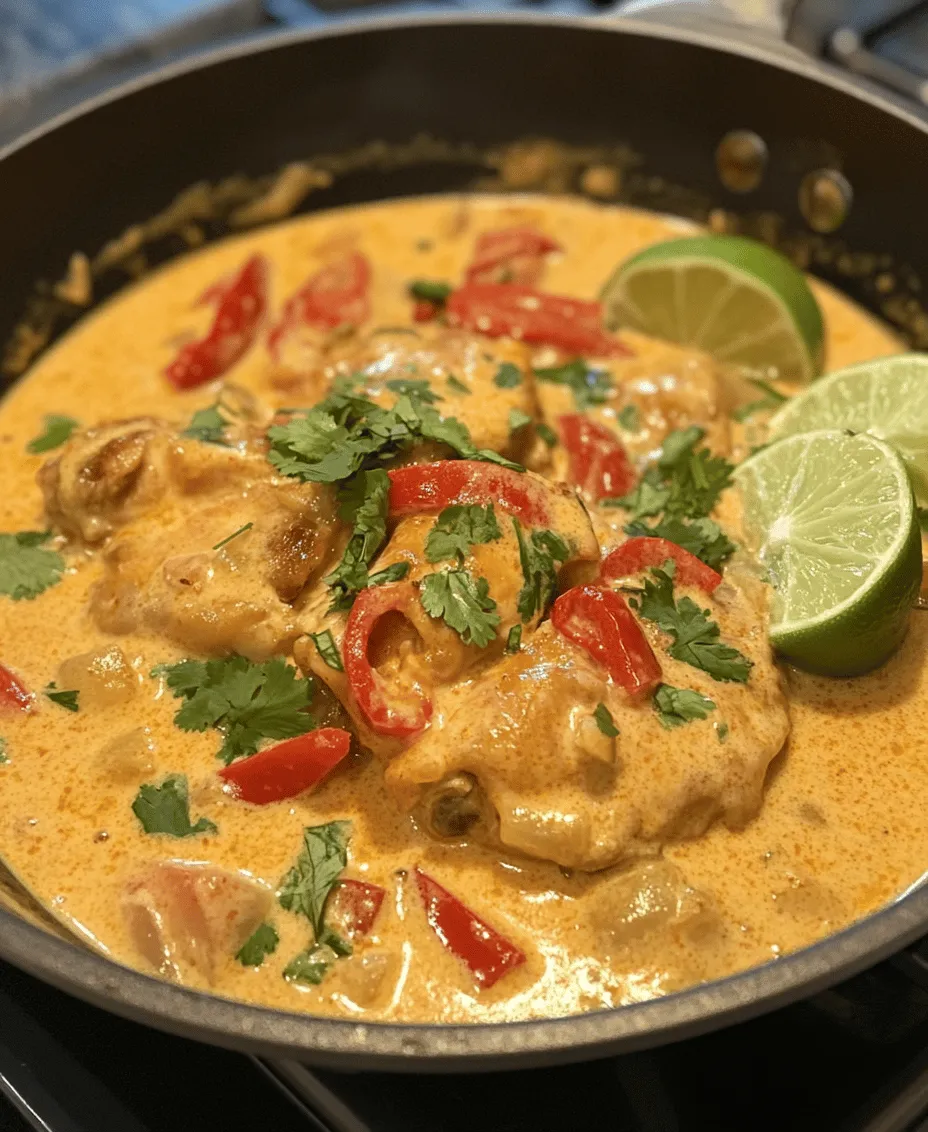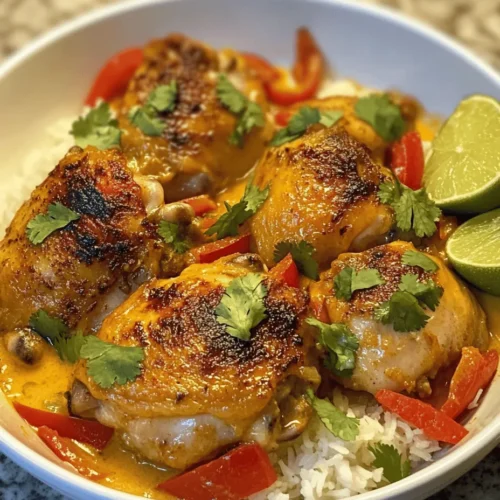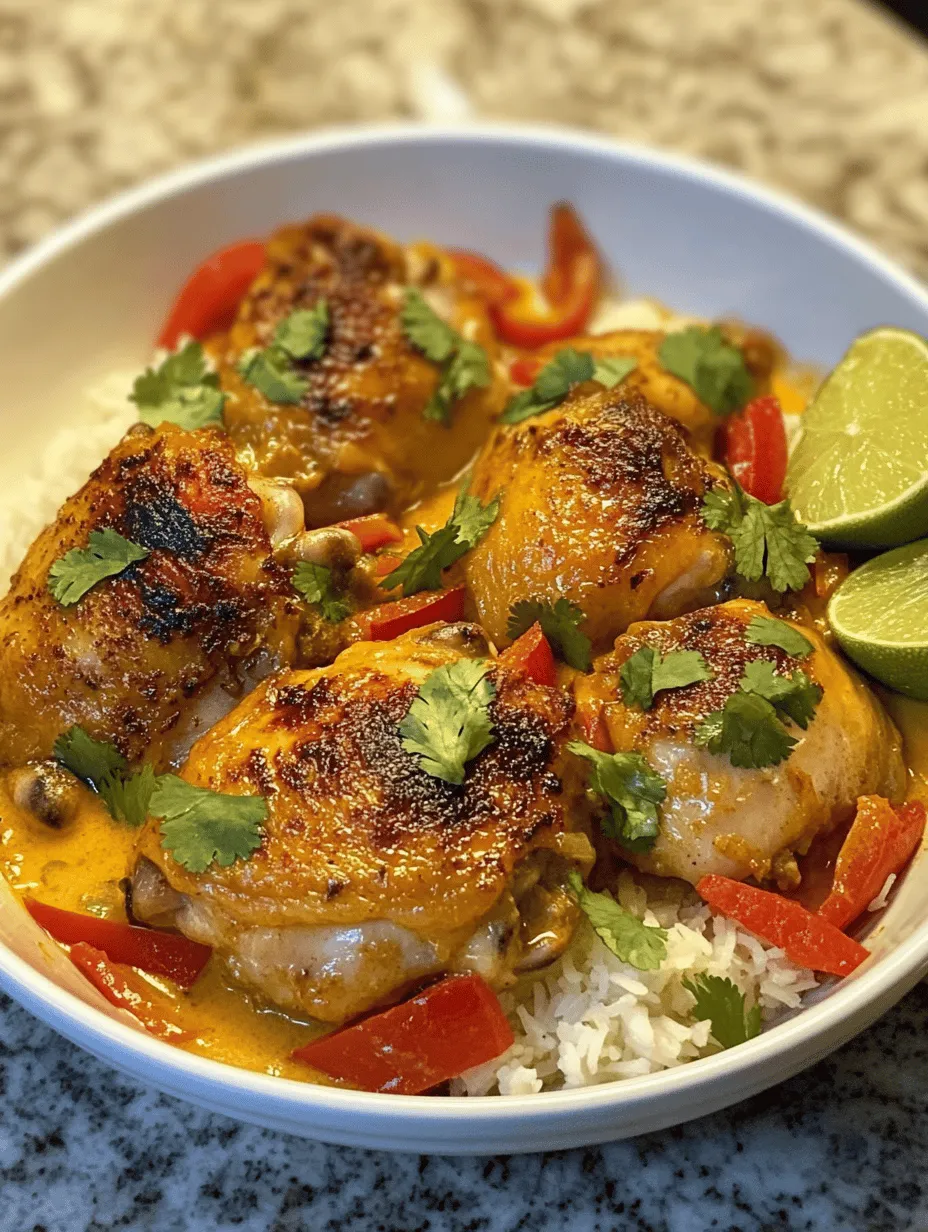Introduction
Brazilian cuisine is a vibrant tapestry woven from the diverse cultural influences of its indigenous peoples, Portuguese colonizers, and African slaves. The result is a culinary landscape that is rich in flavor, color, and texture. From the feijoada, a hearty black bean stew, to the famous pão de queijo, a cheese bread beloved by many, Brazilian food offers a unique gastronomic experience that captures the essence of its multicultural heritage. One standout dish that embodies the spirit of Brazil is *Spicy Brazilian Coconut Chicken*.
This enticing dish not only showcases the bold flavors characteristic of Brazilian cooking but also combines the creamy richness of coconut milk with the heat of spices. The harmony of these ingredients creates a meal that is both comforting and exciting to the palate. Whether you are looking to impress guests or just enjoy a delicious homemade dinner, Spicy Brazilian Coconut Chicken is sure to become a favorite in your kitchen.
Central to the success of this recipe is the use of fresh, high-quality ingredients. The vibrant flavors come from a careful selection of spices, herbs, and other elements that work together to create a balanced and satisfying dish. This article will guide you through the process of preparing this delightful meal, focusing on the ingredients, preparation steps, and cooking techniques that ensure an authentic Brazilian experience.
Understanding the Ingredients
To prepare Spicy Brazilian Coconut Chicken, understanding the key ingredients is essential. Each component plays a significant role in delivering the dish’s signature flavors and textures.
Boneless, Skinless Chicken Thighs
For this recipe, boneless, skinless chicken thighs are the preferred choice. Unlike chicken breasts, thighs offer a richer flavor and remain moist during cooking, making them ideal for a dish that requires a longer cooking time. Their slightly higher fat content ensures that they absorb the marinade beautifully, resulting in tender, succulent chicken that is bursting with flavor.
Coconut Milk
Coconut milk serves as the creamy base for this dish, providing a luscious texture and a hint of sweetness that balances the spices. It is essential to choose high-quality coconut milk, ideally from a can rather than a carton, as it tends to be thicker and richer. The creaminess of coconut milk complements the heat from the chili paste, creating a harmonious blend of flavors that is quintessentially Brazilian.
Olive Oil, Soy Sauce, and Lime Juice
The marinade for the chicken is built on a trifecta of flavors: olive oil, soy sauce, and lime juice. Olive oil not only helps to tenderize the chicken but also adds a fruity note that enhances the overall flavor profile. Soy sauce contributes a savory umami element, while lime juice introduces acidity that brightens the dish and balances the richness of the coconut milk. Together, these ingredients create a marinade that seeps into the chicken, infusing it with flavor.
Red Chili Paste
A key ingredient in this recipe is red chili paste, which adds a distinctive kick to the dish. The paste can vary in heat levels, so it’s important to adjust the quantity according to your spice tolerance. It brings depth to the dish and enhances the overall flavor without overwhelming the palate. The combination of chili paste with coconut milk results in a creamy sauce that is both spicy and satisfying.
Garlic and Ginger
Aromatic elements such as garlic and ginger are critical in elevating the flavors of Spicy Brazilian Coconut Chicken. Garlic adds a pungent aroma and depth of flavor, while ginger introduces a warm, zesty note that complements the spices beautifully. Together, they create a fragrant base that enhances the overall dish and provides a delightful aroma as it cooks.
Spices: Cumin and Paprika
Cumin and paprika are traditional spices that play a vital role in Brazilian cooking. Cumin adds a warm, earthy flavor that pairs exceptionally well with the chicken and coconut milk, while paprika contributes its vibrant color and a mild smokiness. When combined, these spices create a robust flavor profile that is characteristic of Brazilian cuisine.
Vegetables
In addition to the chicken and sauce, a variety of vegetables can be added to the dish for nutritional value and texture enhancement. Bell peppers, onions, and carrots are commonly used, providing not only a pop of color but also essential vitamins and minerals. These vegetables not only complement the chicken but also soak up the delicious coconut sauce, making every bite delightful.
Preparation Steps
Now that we have an understanding of the key ingredients, it’s time to delve into the preparation steps for Spicy Brazilian Coconut Chicken. Proper preparation is crucial for infusing flavors and ensuring a successful cooking process.
Marination Process
The first step in preparing this dish is marinating the chicken. Marinating is essential as it allows the flavors to penetrate the meat, resulting in a tastier final dish. To create the marinade, combine olive oil, soy sauce, lime juice, red chili paste, minced garlic, and grated ginger in a bowl. Whisk the ingredients together until well combined.
Add the boneless, skinless chicken thighs to the marinade, ensuring that each piece is thoroughly coated. For optimal flavor infusion, it’s recommended to marinate the chicken for at least 30 minutes, although a longer marination time of up to 4 hours or even overnight in the refrigerator will yield even better results. The longer the chicken sits in the marinade, the more pronounced the flavors will be.
Vegetable Preparation
While the chicken marinates, take the time to prepare the vegetables. Chop bell peppers, onions, and carrots into uniform pieces to ensure even cooking. The goal is to create a colorful medley that will enhance the visual appeal of the dish while also providing a variety of textures.
Sautéing the vegetables before adding them to the chicken will help to develop their flavors and ensure they retain a pleasant crunch. Set them aside until the chicken is ready to be cooked.
Cooking Techniques: Searing Chicken for Flavor Development
Once the chicken has marinated, it’s time to cook it. Start by heating a large skillet or Dutch oven over medium-high heat and adding a splash of olive oil. Searing the chicken thighs first is crucial, as it creates a beautiful golden crust that adds depth of flavor to the dish.
Carefully place the marinated chicken thighs in the hot skillet, making sure not to overcrowd the pan. Sear the chicken for about 5-6 minutes on each side, or until golden brown. This process not only enhances the flavor but also locks in moisture, resulting in juicy chicken.
Correct Internal Temperature for Poultry Safety
As you cook the chicken, it’s important to monitor its internal temperature to ensure it is safe to eat. The USDA recommends that poultry should be cooked to an internal temperature of 165°F (75°C). Using a meat thermometer is the most reliable way to check for doneness. Once the chicken reaches this temperature, it is safe to remove it from the heat and proceed with the cooking process.
In the next part of this article, we will guide you through the steps to combine the chicken with the coconut milk and vegetables, creating the rich, flavorful sauce that makes this dish so special. Stay tuned for an exciting journey into the heart of Brazilian cooking as we complete the preparation of Spicy Brazilian Coconut Chicken!

Tips for Achieving a Perfect Sear on Chicken
Searing chicken is a crucial step in developing flavor and texture in your dish. To achieve that perfect golden crust, start with the right chicken cut: boneless, skinless thighs are ideal due to their higher fat content, which helps in better browning.
1. Pat the Chicken Dry: Use paper towels to remove excess moisture from the chicken. A dry surface allows for better contact with the hot pan, promoting a nice sear.
2. High Heat is Key: Preheat your skillet over medium-high heat. It should be hot enough that a drop of water sizzles upon contact.
3. Use Enough Oil: Add a tablespoon of oil (coconut or vegetable) to the hot skillet. Swirl it around to coat the bottom. The oil should shimmer but not smoke.
4. Don’t Overcrowd the Pan: Place the chicken pieces in a single layer, ensuring they have space between them. If necessary, sear in batches to maintain the pan temperature.
5. Resist the Urge to Move It: Let the chicken cook undisturbed for about 5-7 minutes, depending on thickness. This will help develop a crust. Flip the chicken only once to prevent steaming.
Importance of Using Reserved Marinade in the Sauce
The marinade not only infuses the chicken with flavor but also serves as a base for your sauce. Using the reserved marinade is essential as it contains spices and aromatics that will deepen the flavor of your dish.
1. Safety First: Always reserve a portion of the marinade before adding it to the chicken. This prevents cross-contamination and ensures the marinade remains safe to consume.
2. Flavor Boost: When simmered, the marinade ingredients meld together, enhancing the overall taste profile of your sauce.
3. Balance and Cohesion: The reserved marinade ties the sauce back to the chicken, creating a harmonious dish that feels cohesive in both flavor and texture.
Techniques for Achieving the Right Sauce Consistency
A well-balanced sauce should have a velvety texture that clings to the chicken. To achieve this, follow these techniques:
1. Simmering: After adding the reserved marinade to the pan, allow it to simmer gently. This process helps concentrate the flavors and thicken the sauce.
2. Adding Coconut Milk: Incorporate coconut milk slowly, allowing it to emulsify with the marinade. This will create a creamy consistency that complements the spices.
3. Thickening Agents: If the sauce is too thin, you can thicken it further by creating a slurry with cornstarch and water or by reducing it over low heat until it reaches your desired thickness.
How to Know When the Sauce is Perfectly Thickened
The right sauce consistency can be determined through a couple of visual and tactile cues:
1. Coating Test: Dip a spoon into the sauce; it should coat the back of the spoon without running off immediately. If it does, continue to simmer until it thickens further.
2. Bubble Formation: Look for gentle bubbles breaking the surface, which indicates that the sauce is actively reducing and thickening.
3. Time: Typically, a simmer of about 10-15 minutes after adding the coconut milk will yield a perfect sauce consistency.
Plating and Presentation
The visual presentation of your dish is just as important as its flavor. Here are some tips for plating your Spicy Brazilian Coconut Chicken beautifully:
1. Garnishing with Cilantro and Lime: Fresh cilantro adds a vibrant green color and a burst of freshness. Finely chop the cilantro and sprinkle it generously over your chicken. A wedge of lime on the side not only enhances the dish’s visual appeal but also offers a zesty finish when squeezed over the chicken.
2. Visual Appeal: Consider the color contrast on your plate. The golden-brown chicken against the creamy coconut sauce and bright green cilantro creates a visually striking dish. Use a white plate to make the colors pop.
3. Serving Suggestions: Pair your chicken with fluffy white rice, which absorbs the delicious sauce, or a fresh salad that can provide a crunchy texture contrast. A side of black beans can also honor the Brazilian tradition, creating a nutritious and balanced meal.
Cultural Significance
Understanding the cultural roots of Spicy Brazilian Coconut Chicken adds depth to your culinary experience. This dish embodies the vibrant flavors of Brazilian cuisine, which is known for its rich use of spices and tropical ingredients.
1. Culinary Traditions: Brazilian cooking reflects a blend of indigenous, African, and Portuguese influences. The use of coconut and spices in this dish is a testament to the country’s diverse heritage, showcasing how different cultures have come together to create unique flavors.
2. Coconut in Brazilian Cooking: Coconut is a staple ingredient in Brazilian cuisine, often featured in sweets and savory dishes alike. It not only adds richness but also a tropical flair that is quintessentially Brazilian.
3. Spice Usage: The spices used in this recipe—such as cumin, paprika, and chili—are commonly found in Brazilian cooking, contributing to the bold, vibrant flavors that define many Brazilian dishes.
Nutritional Information
Understanding the nutritional makeup of Spicy Brazilian Coconut Chicken can enhance your appreciation for the dish:
1. Calories and Macronutrients: A typical serving of this dish contains approximately 450 calories, with around 20g of fat, 40g of protein, and 30g of carbohydrates.
2. Health Benefits:
– Chicken: A great source of lean protein, chicken helps build muscle and maintain a healthy metabolism.
– Coconut Milk: Provides healthy fats and can help with heart health when consumed in moderation.
– Vegetables: Any added vegetables boost fiber and vitamin content, contributing to overall health.
Variations and Substitutions
To cater to various dietary preferences or ingredient availability, consider the following variations:
1. Gluten-Free and Dairy-Free: This recipe is naturally gluten-free and dairy-free. However, always check your ingredient labels for any possible gluten-containing additives.
2. Vegetarian and Vegan Options: Substitute chicken with firm tofu or a mix of seasonal vegetables. Tofu absorbs flavors well, making it a delicious alternative.
3. Adjusting Spice Levels: If heat is a concern, decrease the amount of chili used or opt for milder varieties. Conversely, for those who enjoy a kick, feel free to increase the spice levels to suit your palate.
4. Flavor Profile Variations: Experiment with different spices such as turmeric for an earthy flavor or ginger for added warmth. These tweaks can introduce new dimensions to your dish while honoring its Brazilian roots.
Conclusion
Spicy Brazilian Coconut Chicken is a delightful representation of Brazil’s rich culinary landscape, combining vibrant flavors, creamy textures, and a hint of spice. From the first bite, you will experience a blend of tropical coconut and aromatic spices that transport you to the heart of Brazil.
Embracing this recipe allows you to explore diverse cuisines while enjoying homemade comfort food. Whether you serve it for family gatherings or as a special treat for yourself, this dish promises a satisfying and flavorful experience.
Try your hand at this recipe and enjoy a taste of Brazil in your own kitchen. Cooking is a joyful journey of discovery, and this dish is just one of the many treasures waiting to be explored.



